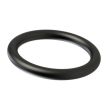EPDM 80, Peroxide, Black
- O‑ring EPDM 80 BlackPeroxide Type: OR-111
Dimensions: 10.78 x 2.62Part number: 471978In StockMore Details - O‑ring EPDM 80 BlackPeroxide Type: OR-242
Dimensions: 101.2 x 3.53Part number: 472160Delivery time: 3-5 daysMore Details - O‑ring EPDM 80 BlackPeroxide Type: OR-155
Dimensions: 101.27 x 2.62Part number: 472161Delivery time: 3-5 daysMore Details - O‑ring EPDM 80 BlackPeroxide Type: OR-346
Dimensions: 104.14 x 5.33Part number: 472163Delivery time: 3-5 daysMore Details - O‑ring EPDM 80 BlackPeroxide Type: OR-244
Dimensions: 107.54 x 3.53Part number: 472168Delivery time: 3-5 daysMore Details - O‑ring EPDM 80 BlackPeroxide Type: OR-348
Dimensions: 110.49 x 5.33Part number: 472171Delivery time: 3-5 daysMore Details
EPDM - Ethyleen-propyleen-diene-rubber
EPDM can be used in a wide temperature range, has good resistance to ozone, weathering and ageing and is resistant to hot water and steam. Peroxide cured EPDM materials have better resistance to temperature and chemicals and obtain better
compression set values than sulfur cured EPDM.
EPDM has good resistance to:
- hot water and hot steam
- many polar solvents (e.g. alcohols, ketones, esters)
- many organic and inorganic acids an bases
- washing brines
- silicone oils ans silicone greases
- glycol-bases blake fluids (special grades required)
- ozon, weathering, ageing
EPDM is not resistant to:
- all kinds of mineral oil products (oils, greases, fluels)
Application temperature range:
- -55°C to +150°C (peroxide cured)
The difference between peroxide or sulfur cured EPDM O-rings:
EPDM is a versatile O-ring compound. Important properties of EPDM are the excellent heat, ozone and weather resistance. During the production of EPDM O-rings, the compound can be cured with sulfur or peroxide. The peroxide variant has a better chemical and thermal resistance compared to sulfur and is resistant to higher temperatures. Peroxide also has a lower compression set and lasts longer. The peroxide variant also does not stain metals and PVC. Curing with sulfur is more common, is more readily available, is less likely to crack and is better priced.










